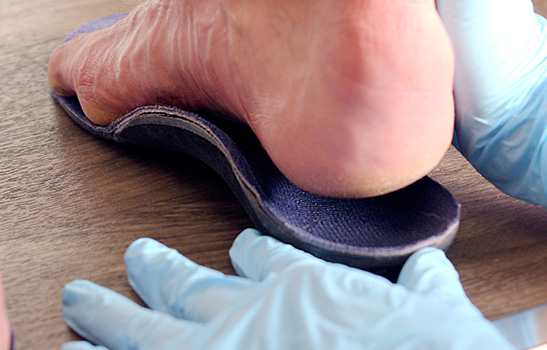Twisted ankle, rolled ankle or ankle sprain
A condition characterized by injury to the ligaments of the ankle after excessive torsion. More than one ligament may be affected. The impact of a sprained ankle can vary from mild damage to partial or complete tearing of a ligament. The degree of damage determines the classification (grade) of the ankle sprain.
See the causes See the long term complications See how to relieve yourself at home
Signs and symptoms of an ankle sprain
- Sharp or dull pain felt around the ankle following excessive rotation
- Difficulty moving the ankle
- Placing weight on the affected foot may be difficult or prove impossible
- Swelling and redness in the area of the sprain
- Bruising may occur
- Ankle instability and loss of balance
- Pain on the side of the leg
- Some patients complain of a burning sensation
What are the causes of an ankle sprain
Sprained ankles are the result of direct injury caused by a sharp turning motion of the foot. While most sprains occur when the foot rolls outward, the condition can occur with movement in any direction.
Sprains occur for many reasons. For example, they can be triggered by walking on an uneven surface or by wearing high heels. Many sprains also occur during sports, especially those involving jumps (basketball, volleyball, etc.) and sudden changes in direction of movement (soccer, tennis, etc.). Sometimes, simply not paying attention is enough to cause a sprain (missing a step, walking too close to the sidewalk curb, stepping into a hole, etc.).
Some people are more predisposed to sprained ankles. Risk factors include:
- Unstable foot structure (high arches, flat feet)
- Hypermobility in the feet
- Previous sprains
Progression and consequences of a twisted ankle
Even after the swelling, bruising and pain go away, a sprained ankle may not completely heal. At this stage, the majority of people feel fine so they tend to stop treatment and resume their regular activities. Unfortunately, this puts them at high risk of spraining their ankle again, often more severely. In fact, the more times your sprain your ankle, the more likely you are to sprain it again. That’s because the ligaments that surround the joints play an important role in giving us feedback on how they are positioned in space, this is known as proprioception. When the ligaments in the ankle are stretched and torn due to a sprain, proprioception thus balance is compromised, making additional sprains more likely.
Excessive stretching of a ligament can also lead to injury in the supporting muscles and tendons. That’s why it’s not uncommon for ankle sprains to be accompanied by other conditions like tendinitis, tenosynovitis or muscle spasms.
In addition, the stretching and tearing of the ligaments caused by a sprained ankle can cause translation of the talus bone, which is located right in the ankle joint below the shinbone. No muscles or tendons attach to the talus. Thus, in the absence of treatment, there’s nothing to move the bone back into place. Like a domino effect, the misplaced bone can push into the other bones of the feet, affecting their alignment as well. This process is characterized by a blockage sensation, reduced ankle mobility and stiffness felt around the top of the foot. Because the talus bone is so important for the foot’s function, its displacement can compromise the overall mechanics of the foot and lead to long-term pain as distant as the hips. In fact, biomechanical problems can sometimes be attributed to past ankle sprains, even if these occurred years ago.
Chronic misplacement of the talus bone can also lead to the build-up of calcium deposits at the front of the ankle. Unless surgery is performed, this can irreversibly restrict the ankle’s range of motion.
How to relieve a rolled ankle pain at home
Apply the RICE method immediately after your injury to limit swelling and pain:
1.Rest:
Limit activities and movement. Use a walking cane or crutches if necessary.
2.Ice:
Apply ice for 10-15 minutes every hour.
3.Compression:
Apply an elastic bandage.
4.Elevation:
Elevate the foot using a cushion or reclining armchair.
Diagnostic of an ankle sprain
- X-rays must be conducted to rule out suspected fractures, as a twisted ankle occasionally leads to a broken bone rather than a torn ligament. X-rays also make it possible to verify the alignment of the bones in the foot.
- Ultrasound is an excellent imaging technique that can be used to observe the condition of the ligaments, muscles and tendons involved in the sprain. This technology also allows us to establish the severity of the sprain.
What can my podiatrist do about an ankle sprain?
Once the problem has been diagnosed and its potential causes identified, your podiatrist will be able to recommend a personalized treatment plan for your condition.
1. Physical therapy:
neurocryostimulation, ultrasound, stabilization taping and neuro-proprioceptive taping can help reduce the swelling more rapidly and stabilize the ankle.
2. Ankle brace:
An appropriate ankle brace may be recommended. The brace should be worn at all times for one month after injury, and for the first six months after injury during sports activities. Ankle braces provide compression and help prevent recurrence.
3. Medication:
Painkillers, muscle relaxants and/or anti-inflammatory drugs may be prescribed.
4. Manipulative therapy:
Manipulative therapy initially helps reduce the swelling. In the longer term, it helps realign the bones of the foot and ankle.
5. Strengthening and balance exercises:
You’ll be recommended a personalized exercise program you can do at home to help you regain strength, mobility and stability.
6. Plantar orthotics:
Plantar orthotics are very effective at lowering the risk of repeated sprains among patients with an unstable foot structure. The orthotics are custom-moulded to your feet and provide them with a larger supporting surface area, which helps improve proprioception in patients dealing with the consequences of past sprains.
7. Walking boot:
In the most severe cases, where the patient has great difficulty placing weight on their foot or where a fracture is suspected, a controlled ankle motion walking boot may be recommended.
How to prevent an ankle sprain
- Warm up well before exercise and sports activities.
- Include balance training in your workouts. You can do this by modifying exercises you already do (do them while balancing on one leg, using a stability ball, etc.).
- Wear appropriate footwear for your sport or activity. For example, if you’re hiking up a mountain with a backpack, wear hiking boots, not running shoes!
- Don’t neglect to follow your treatment plan, even if the sprain is minor.
- Avoid high heels.
- Pay attention to your body during sports activities and take breaks at the sign of fatigue.
I don't feel pain anymore, so my sprained ankle must be completely healed!

On the contrary! Extra care must be taken at this risky stage. All too often, people return to their regular activities without taking the necessary precautions to avoid recurrence. The full recovery of strength and stability—not the absence of pain—is what defines a successful treatment.
And if it was not an ankle sprain
- Ankle fracture (fibula, tibia ou talus)
- Fracture of the talus cartilage (osteochondritis dissecans)
- Fracture at the base of the fifth metatarsal
- Tendinitis or tenosynovitis of the peroneus (fibularis), tibialis posterior or tibialis anterior muscles
- Anterior or posterior ankle impingement
- Sinus tarsi syndrome
- Tarsal tunnel syndrome
- Cuboid syndrome
- Inflammatory arthritis (gout, ankle arthritis)


